We completed the five-day Camino de Santiago pilgrimage yesterday, and celebrated by having dinner twice in about five hours.
Walking 13 or 14 miles a day is enough to work up an appetite that can be acknowledged without fear of gaining weight. So there is that.
Thinking back, I failed to mention, over the past five blog posts, several concepts I found interesting, and this is where I will get around to several of them.
Like the issue of luck.
–Santiago de Compostela, in northwest Spain, gets a lot of rain, to the tune of 70 inches annually and more than five inches in April which, on average, has 14.4 days of rain. Thus, our being out in the open for five consecutive days … history would suggest we would have been rained on two or three days.
We were rained on not at all. Not a drop.
The camino sites often note how often it rains across northern Spain and repeatedly warn that this and that bit of a stage will be reduced to sucking mud during rain, also noting the average April high temperature of 61 degrees Fahrenheit.
All we saw were a few wet spots, and one or two places where streams were crossing the path — but not in enough volume that we couldn’t jump over them. Ins tead, we had cool/cold mornings and warm and sunny afternoons that reached into the 70s (or more). We brought ponchos but never broke them out of their packaging. We had far greater need for sunscreen.
That’s pure dumb luck.
–More luck. Travel schedules pushed us toward a Saturday, April 8, start. We knew the following weekend was Easter , but we did not grasp how that would impact us in a positive way.
When two of us reached the cathedral in time for the noon pilgrims’ mass on Wednesday, we were treated to the swinging of the botafumeiro, one of the classic events tied to the walk to Santiago. Later that night was the city’s annual pre-Easter passion play — with hundreds of local residents wearing hoods and carrying chains and playing horns and drums as they slowly paraded around the cathedral. It was an extremely colorful event — and we just walked into it.
Had we arrived a day later, today, the noon mass, because it was Maundy Thursday, would have been about absolution (and not pilgrims, with no botafumeiro swinging) and the local parade would have happened the night before we arrived. More luck.
–Pilgrims tend to walk with the same X number of hundreds of people for however long they do the pilgrimage. Certain towns are natural stopping points, and a high fraction of people will stay in those towns. In our case, Sarria, Portomarin, Palas de Rei, Arzua, Pedrouzo and, finally, Santiago.
On the day you get to Santiago, and are wearing your smelly and perhaps silly peregrino clothes, you will recognize a dozen or two people you saw on the daily walks and come to feel attached to a particular cohort of pilgrims. The people one day behind or one ahead? Just a bunch of strangers.
–We expected the line to get our compostela, or diploma, certifying that we had completed the camino, and listing the distance covered, to be scary long. In fact, the queue moved along at such a rapid pace that one of us who had forgotten to get the second document rejoined the line and got the other document just minutes later. The camino registrars were smiling, friendly and operated 14 at a time.
–I believe the Camino de Santiago is a brilliant idea in just about every way. It gets individuals walking and shows them they probably can exert themselves more than they ever believed. (The five longest walks of my life were during the five days of the 2017 camino.) It is good for the local economy, which sees hotel stays and restaurant business rise. Even on the local-local level, someone who turns an old barn on the trail into a camino-necessities shop (selling water, soda, trail mix, etc.) can make some money. It brings 275,000-plus pilgrims to Santiago and it is a great public-relations success for the Roman Catholic Church, which is behind the whole of the endeavor. Win-win for just about every except …
–Some of the old-timers who did the camino a time or three back in the day worry about where it is headed, creating great, ongoing debates.
Among them: What is the proper length of walk to be a real pilgrim? Those who start at the border of France and Spain tend to suggest that 25-30 days of walking is required; otherwise, you are just a tourist or, even if you did 74 miles in five days (as we did), you are only a glorified tourist.
Also, what is the proper decorum for a camino pilgrim? The traditionalists believe “doing it right” involves 1) quiet contemplation; 2) absolutely no audible-to-others music; 3) a close-enough identification with the event that some sort of epiphany (religious or otherwise) results; 4) staying at albergues all along the route. The latter are the simple, ultra-cheap (six to 12 euros) accommodations that feature bunk beds and communal living. To stay in hotels, even two-star hotels, is held by some to be an inauthentic pilgrimage.
Perhaps the greatest debate of all: Is popularity ruining the Camino de Santiago?
Some veteran hikers recall the “simple” times of the early 1990s, when fewer than 10,000 pilgrims reached Santiago in any given year and a day on the camino might mean seeing only a few dozen other pilgrims.
As recently as 2005, 94,000 people completed the walk. In 2016, more than 275,000 pilgrims reached the city. That is a three-fold gain in barely a decade, and many of the veteran pilgrims believe a crowded camino diminishes and devalues the experience, noting how rare it is to find an hour or three where no one is in sight, and how that interrupts introspection. They also worry about the impact on the trail; one veteran we met complained bitterly about the number of facial tissues she saw on the trail. And yes, litter was a problem in some areas.
One way to address trail maintenance would be to charge a nominal fee, say five euros, for the compostela at the end. Multiply that by last year’s 275,000-plus pilgrims and you have nearly 1.4 million euros annually to maintain the pathway. The U.S. Park Service charges far more, as do the African national parks.
Camino veteran Bill Bennett, who has done a movie on the camino, recently posted a long speech given by a peregrino from the 1990s who fears the event will become “Disneyfied” as “marketers and Capitalists” (she capitalized the C) realize it can be a money-making opportunity.
OK, that is possible. At the moment, however, the people who seem to be benefiting from the traffic on the camino (which reaches more than 50,000 pilgrims in the month of August) seem mostly to be local businesses, including the mom-and-pop operations — like the booming lunch stop Mariluz’s, on the Portomarin-to-Palas de Rei leg.
–Another old-timer complaint — that the camino has lost its spiritual element, particularly among walkers from the U.S., which has a wide and deep history of individuals looking to “test themselves” on some difficult physical venture. Everyone, dammit, should be communing with nature and pondering how they can be better people, rather than trying to impress their friends on social media, is how the argument goes.
–I give the keepers of the camino credit for making sure that as much of the walk as possible is in the country or through farmland. The 547 highway is not far from the trail over the final four days, but again and again the trail designers take the route into the woods by 100 yards or so, and it becomes easy to forget a busy highway is not far off.
Some pet peeves.
–The guys (and they have to be guys, right?) who pry out the “kilometers to Santiago” plates from the distinctive directional plinths. on the trail. I believe all of those people instantly forfeit whatever spiritual/religious benefits may have been possible on the camino. The kilometer markers are nearly extinct, the final 20 miles, which makes it hard for pilgrims to get a sense of how far they have come — as well as giving the markers a sad, vandalized, gap-toothed look.
–Bicyclists. They make up about 5 percent of the traffic and about 95 percent of the terror on the trail. On downhill sections they come speeding past the hikers, who often are scattered across the width of the trail, and the biers expect walkers to get the hell out of their way, which often is something close to “at the last possible moment.” The good news? Cyclists used to be 20 percent of camino traffic.
Final thoughts …
Camino statkeepers say Spain provides about half of all pilgrims and women make up a slight minority of peregrinos. Our experience on the trail over the past week led us to believe Spaniards are about two-thirds of the walkers and women are definitely a majority, too, perhaps as high as 60 percent. It will be interesting to see if those trends continue. Maybe it’s just an April thing. Or a school-break thing.
It was a very positive experience for most of us, far as I can tell. It got us in touch with nature in countryside that is stunningly verdant. We had a chance at long conversations with our immediate group or even strangers from countries ranging from Germany to Japan.
A beer at the end of six or seven or eight hours of walking became a simple pleasure.
It seemed authentic, still, to me … despite what the veterans say.
The camino could be better … but not by much.

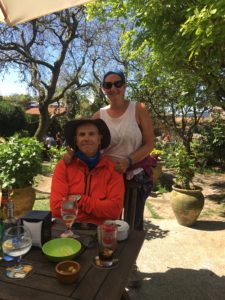
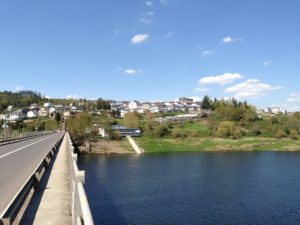
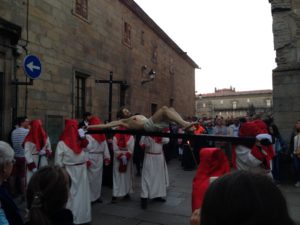
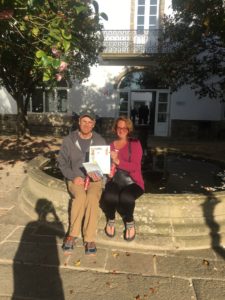
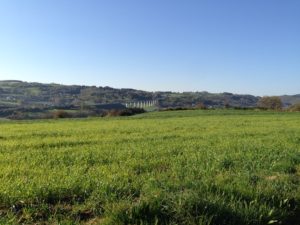
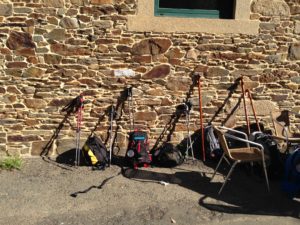
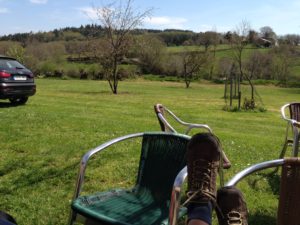
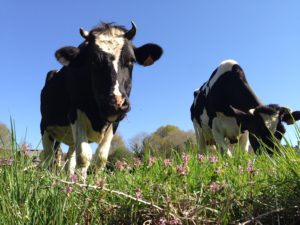
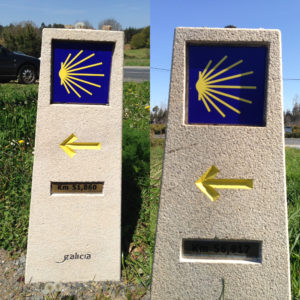
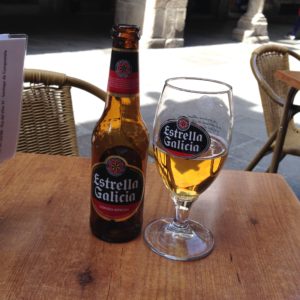
2 responses so far ↓
1 David // Apr 13, 2017 at 7:25 PM
Congratulations are definitely in order. You are the second of my friends to complete the camino (my other friend, a retired football coach, did a longer version). I think you may be correct that the time of year has something to do with the percentage of Spaniards. His walk (in the fall) was much more international in character.
2 Santiago Ways // May 11, 2017 at 1:15 AM
Very nice post! I loved it 🙂 Thanks for sharing your experience about the Camino. Galician beer is fantastic, of course it’s even better after a loooong walk like yours. You should do the Camino again, it’s addictive!
Leave a Comment